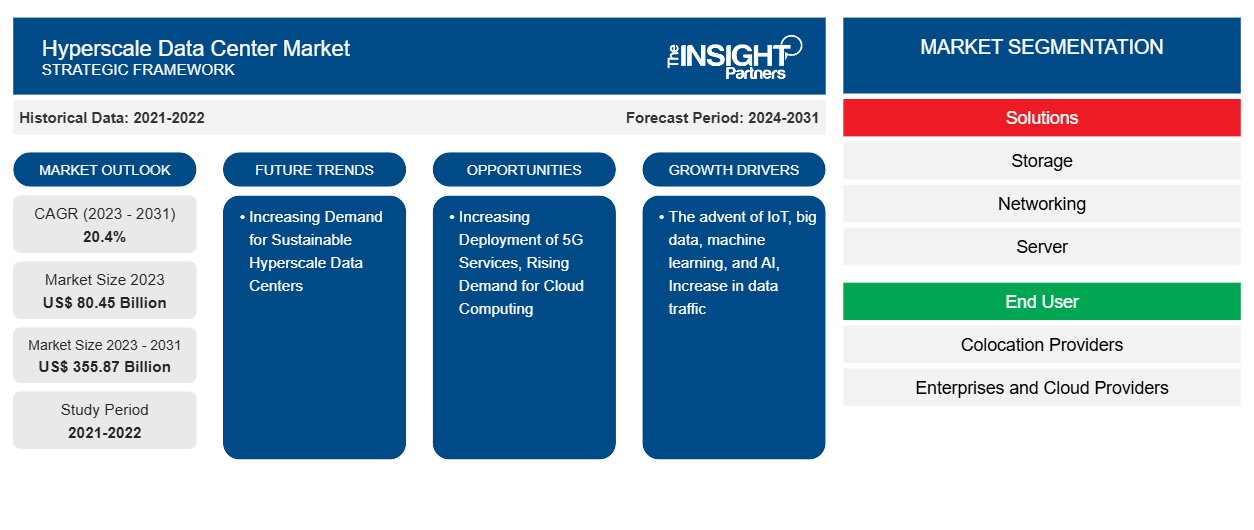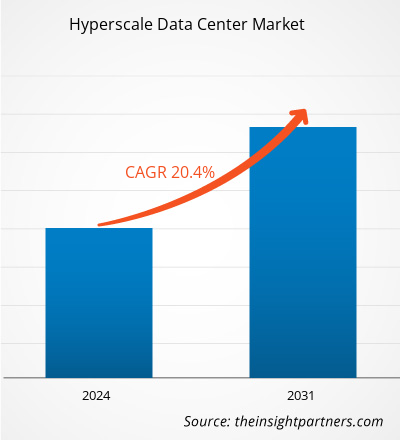The hyperscale data center market size is expected to reach US$ 355.87 billion by 2031 from US$ 80.45 billion in 2023. The market is estimated to record a CAGR of 20.4% from 2023 to 2031. The integration of IoT is likely to bring in key market trends during the projected period.
Hyperscale Data Center Market Analysis
The report includes growth prospects owing to the current hyperscale data center market trends and their foreseeable impact during the forecast period. Hyperscale data centers are gaining significant demand because of their features such as high computing, storage, and bandwidth capacities. Moreover, their ability to move massive amounts of data adds to their popularity. These data centers are cost-effective, scalable, safer, more dependable, and less harmful to the environment. Hyperscale data centers offer services such as data storage, management, backup, and recovery. They also power online gaming communities, facilitate high-volume transactions, and support cutting-edge technology implementation (such as big data, machine learning, and artificial intelligence). As a result, many companies and governmental organizations have begun to manage their own data centers or employ third parties such as Google and Amazon for cloud-based storage or even server rentals, which would continue to fuel the hyperscale data center market growth during the forecast period.
Hyperscale Data Center Market Overview
Hyperscale data centers, with their enormous computing, storage, and bandwidth capacities, as well as their potential to handle enormous volumes of data transfers, have revolutionized the data center industry. This development has completely changed the way businesses interact and collaborate. With the adoption of work-from-home policies in various organizations worldwide since the onset of the COVID-19 pandemic, the demand for data centers has been continuously increasing. Various large organizations such as Facebook and Twitter, and financial and professional service firms allowed their employees to work from home during the pandemic, which became one of the main reasons for the increase in the demand for hyperscale data centers worldwide.
Customize This Report To Suit Your Requirement
You will get customization on any report - free of charge - including parts of this report, or country-level analysis, Excel Data pack, as well as avail great offers and discounts for start-ups & universities
Hyperscale Data Center Market: Strategic Insights

-
Get Top Key Market Trends of this report.This FREE sample will include data analysis, ranging from market trends to estimates and forecasts.
Hyperscale Data Center Market Drivers and Opportunities
Advent of IoT, Big Data, Machine Learning, and AI Drives Hyperscale Data Center Market Growth
The Internet of Things (IoT), big data, machine learning, and artificial intelligence (AI) are a few technologies that generate massive data volumes, require low-latency processing, and demand localized computing resources. IoTExpress Technologies Pvt. Ltd. projected the number of IoT devices to surpass 15 billion by the end of 2023 in Asia Pacific, recording a 55% increase from 2020. Additionally, these devices are expected to generate 79.4 zettabytes (ZB) of data by 2025. IoT generates huge volumes of data that must be processed, stored, and analyzed in real time. IoT devices are widely used across the region, connecting various physical objects and enabling data collection and communication. The data centers positioned at the edge of the network can provide local computing power, storage, and analytics capabilities, reducing the latency and bandwidth requirements while transmitting data to a centralized data center. It can also enable real-time decision-making and facilitate IoT deployments across the manufacturing, healthcare, transportation, and smart city industries. Further, processing and analyzing such massive datasets require significant computational power and storage capabilities. Hyperscale data centers offer a scalable and distributed architecture, allowing organizations to process and analyze big data. Moreover, they enhance data processing efficiency and enable real-time analytics. Also, machine learning and AI algorithms require substantial computational resources for training and inference tasks. Hyperscale data centers provide the necessary processing power and storage capabilities to perform these resource-intensive tasks in the vicinity of the data source. Organizations can reduce the latency by deploying hyperscale data centers at the edge. This enables real-time decision-making, enhances AI-driven applications, and supports use cases such as autonomous vehicles, intelligent video analytics, predictive maintenance, and personalized recommendations. Therefore, the advent of technologies such as the IoT, machine learning, big data, and AI bolsters the hyperscale data center market.
Rising Demand for Cloud Computing
Cloud computing provides a cost-effective way to handle data, enabling organizations to store and process it in a centralized location without investing in expensive hardware and infrastructure. The increased adoption of cloud computing services propels the demand for hyperscale data center services. The integration of cloud technologies with interconnected devices and systems has resulted in an increased preference for these devices, resulting in a growing need for high-speed, low-latency network connectivity. Hyperscale data centers offer a secure hardware environment to store and access data, which is essential to support IoT and cloud-based applications, as well as help save overall costs.
With the growing adoption of cloud-based technologies, key players in the hyperscale data center market are establishing new units for their businesses to make the cloud and digital infrastructure more accessible. In September 2021, Vantage Data Centres opened a new facility in APAC with the help of two acquisitions and an equity raise of US$ 1.5 billion led by DigitalBridge Investment Management. With this expansion, the company began offering cloud-based services across Tokyo and Osaka (Japan), Hong Kong (China), Kuala Lumpur (Malaysia), and Melbourne (Australia). The launch of new data centers is attracting more customers to leverage the services of advanced technologies. Thus, the ongoing proliferation of cloud-based services is expected to bolster the hyperscale data center market growth during the forecast period.
Hyperscale Data Center Market Report Segmentation Analysis
Key segments that contributed to the derivation of the hyperscale data center market analysis are solution, end user, and vertical.
- Based on solution, the market is divided into storage, networking, server, security, and others. The storage segment held the largest hyperscale data center market share in 2023.
- By end user, the market is segmented into enterprises, colocation providers, and cloud providers. The colocation providers segment dominated the market in 2023.
- In terms of vertical, the hyperscale data center market is segmented into BFSI, telecom and IT, media and entertainment, government and public, and others. The BFSI segment dominated the market in 2023.
Hyperscale Data Center Market Share Analysis by Geography
- The hyperscale data center market is segmented into five major regions: North America, Europe, Asia Pacific (APAC), the Middle East & Africa (MEA), and South & Central America. North America dominated the market in 2023, followed by Europe and APAC.
- North America held the largest hyperscale data center market share in 2023. Key North American countries are mostly focused on improving corporate infrastructure and developing new technologies. Significant volumes of data are being generated with advancements in the corporate sector, and this data needs to be efficiently handled and stored. The majority of the dominant companies in the data center market are headquartered in North America. In addition, organizations are progressively utilizing managed services, colocation, cloud services, and additional hybrid methods to introduce novel products and services, evaluate innovative business models, and establish stronger connections with their clientele. Thus, all the above factors are fueling the growth of the hyperscale data center market in the region.
Hyperscale Data Center Market Regional Insights
The regional trends and factors influencing the Hyperscale Data Center Market throughout the forecast period have been thoroughly explained by the analysts at The Insight Partners. This section also discusses Hyperscale Data Center Market segments and geography across North America, Europe, Asia Pacific, Middle East and Africa, and South and Central America.
Hyperscale Data Center Market Report Scope
| Report Attribute | Details |
|---|---|
| Market size in 2023 | US$ 80.45 Billion |
| Market Size by 2031 | US$ 355.87 Billion |
| Global CAGR (2023 - 2031) | 20.4% |
| Historical Data | 2021-2022 |
| Forecast period | 2024-2031 |
| Segments Covered |
By Solutions
|
| Regions and Countries Covered |
North America
|
| Market leaders and key company profiles |
|
Hyperscale Data Center Market Players Density: Understanding Its Impact on Business Dynamics
The Hyperscale Data Center Market is growing rapidly, driven by increasing end-user demand due to factors such as evolving consumer preferences, technological advancements, and greater awareness of the product's benefits. As demand rises, businesses are expanding their offerings, innovating to meet consumer needs, and capitalizing on emerging trends, which further fuels market growth.

- Get the Hyperscale Data Center Market top key players overview
Hyperscale Data Center Market News and Recent Developments
The hyperscale data center market is evaluated by gathering qualitative and quantitative data post primary and secondary research, which includes important corporate publications, association data, and databases. A few of the developments in the hyperscale data center market are listed below:
- Digital Realty, the largest global provider of cloud- and carrier-neutral data center, colocation, and interconnection solutions, and Blackstone Inc. announced that Blackstone-affiliated funds led by Infrastructure, Real Estate and Tactical Opportunities have agreed to establish a joint venture with Digital Realty to develop four hyperscale data center campuses across three metro areas in two continents. The developments are expected to support approximately 500 megawatts (MW) of total IT load upon full build out of all campuses.
(Source: Digital Realty, Press Release, December 2023)
- IXAfrica Data Centres launched East Africa’s first and largest hyperscale AI-ready Data Centre in Nairobi to attract global hypercloud customers. Schneider Electric is underpinning the launch by providing a highly resilient power train including transformers, MV and LV switchgear, power distribution and UPS back-up, and EcoStruxure management solutions.
(Source: Schneider Electric, Press Release, July 2024)
Hyperscale Data Center Market Report Coverage and Deliverables
The "Hyperscale Data Center Market Size and Forecast (2021–2031)" provides a detailed analysis of the market covering the areas mentioned below:
- Hyperscale data center market size and forecast at global, regional, and country levels for all the key market segments covered under the scope
- Hyperscale data center market trends as well as market dynamics such as drivers, restraints, and key opportunities
- Detailed PEST and SWOT analysis
- Hyperscale data center market analysis covering key market trends, global and regional framework, major players, regulations, and recent market developments
- Industry landscape and competition analysis covering market concentration, heat map analysis, prominent players, and recent developments for the hyperscale data center market
- Detailed company profiles
Frequently Asked Questions
What is the incremental growth of the hyperscale data center market during the forecast period?
What are the driving factors impacting the hyperscale data center market?
What are the future trends of the hyperscale data center market?
What is the estimated market size for the hyperscale data center market in 2023?
Which country holds the major market share of the global hyperscale data center market?
Which are the key players holding the major market share of the hyperscale data center market?
Which is the fastest growing regional market?
What will be the market size for the hyperscale data center market by 2031?
- Historical Analysis (2 Years), Base Year, Forecast (7 Years) with CAGR
- PEST and SWOT Analysis
- Market Size Value / Volume - Global, Regional, Country
- Industry and Competitive Landscape
- Excel Dataset
Recent Reports
Related Reports
Testimonials
Reason to Buy
- Informed Decision-Making
- Understanding Market Dynamics
- Competitive Analysis
- Identifying Emerging Markets
- Customer Insights
- Market Forecasts
- Risk Mitigation
- Boosting Operational Efficiency
- Strategic Planning
- Investment Justification
- Tracking Industry Innovations
- Aligning with Regulatory Trends





















 Get Free Sample For
Get Free Sample For